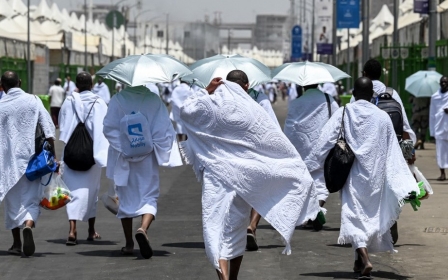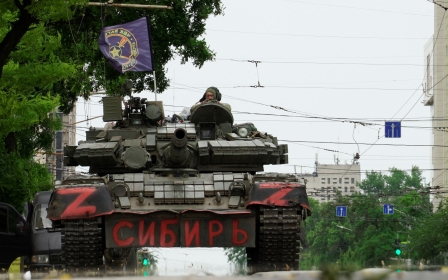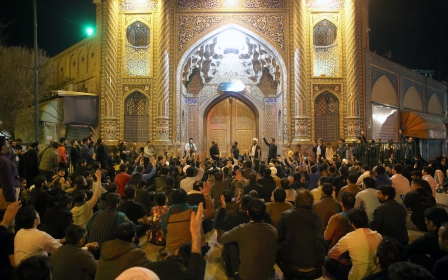Iranian press review: Iranians in Saudi Arabia for Hajj protest against US, Israel

Tehran demonstrates show of power in Hajj
Iranian Hajj pilgrims protested against the US and Israel in the first Hajj pilgrimage since the restoration of ties between Tehran and Riyadh in March this year. The event was organised by the government and the office of Iran's supreme leader in Saudi Arabia's Mount Arafat.
On Tuesday, the Fars news agency, affiliated with Iran's Islamic Revolutionary Guard Corps (IRGC), ran a photo essay of the protest showing Iranians in ihram, the outfit worn to perform Hajj, holding placards in Farsi that read "Down with the USA, The great Satan" and "Down with the childkiller Israel".
According to Fars, Seyyed Abdul Fattah Navab, the supreme leader's representative in the annual Hajj ceremony, and Seyyed Abbas Hosseini, the director of Iran's Hajj and pilgrimage organisation, gave a speech at the protest and read a message that Ayatollah Ali Khamenei sent to the participants.
On Wednesday, photos from the event appeared on the front pages of two ultra-conservative dailies, Kayhan and Iran, hailing the protest as a regional victory for the establishment.
Stay informed with MEE's newsletters
Sign up to get the latest alerts, insights and analysis, starting with Turkey Unpacked
In a statement read at the protest, the organisers stressed their anti-Israel stances. "Now that the resistance front has the upper hand and the childkiller Zionist regime is moving toward decay, the leading priority of the Islamic World must be speeding up the process of the Zionist regime collapse," the statement said.
Missile programme 'forced West back to negotiation'
The IRGC Aerospace Force commander said that Iran's recent military achievements and President Ebrahim Raisi's support for the IRGC missile programme are the two factors that forced western powers to resume negotiations with Iran over its nuclear programme.
The Javan daily, affiliated with the IRGC, quoted Brigadier-General Amir Ali Hajizadeh as saying: "[We have reached here] because our defence capabilities have gained power."
Hajizadeh also criticised former president Hassan Rouhani and his foreign policy team for publicly opposing IRGC's missile programme expansion.
"Foreign powers condemned our missile programme when they witnessed objections from the political elite inside the country. But today, this is not happening any more. When we unveiled the Fattah hypersonic missile, the president attended the ceremony," he said.
On 6 June the IRGC presented Iran's first hypersonic missile, which can reach a speed of 15,000km per hour, with a range of 1,400km.
Tomb of ex-legislator's father becomes shrine
The father of a former legislator, Mir Hemayat Mirzadeh, died 30 years ago, but his tomb has recently been turned into an officially registered shrine, local media reported.
The shrine was constructed at the grave of Mir Aziz Mirzadeh, under the name of "the holy shrine of Imamzadeh Seyyed Aziz' alayhi wa salaam".
"Imamzadeh" is a term meaning the descendant of an imam among the Shia followers of Islam in Iran, Azerbaijan and Afghanistan.
But was Mir Aziz Mirzadeh an imamzadeh? This part is unclear. In 2019, his son, then still a lawmaker, rejected claims that his father was a religious person, saying that people "with their money" made the shrine out of respect.
Shrines in Iran are controlled by the powerful religious Endowment and Charity Organization, whose primary income comes from ordinary people's nazr, or vow to Allah in the form of money and food left at the shrines.
Since the 1979 revolution, the number of shrines has dramatically increased in the country, and according to official data witnessed a 10-fold uptick up to 2019.
Nurses forced to work overtime
Officials at hospitals and health clinics forced nurses to work overtime to overcome a severe shortage of healthcare professionals, Iranian Labour News Agency (ILNA) reported.
According to ILNA, "obligatory overtime work" has become a new issue that nurses face due to a lack of nurses and doctors.
In recent years, the number of Iranian healthcare professionals migrating to other countries has sharply increased.
The report added that some nurses work between 100 and 150 overtime hours on top of 150 regular monthly working hours.
The average monthly salary of nurses in Iran is between $200 and $250. For every hour of overtime, they earn between 32 and 40 cents.
Low salaries, difficult working conditions and discontent with Iran's sociopolitical situation are the main reason for the migration of healthcare professionals from Iran.
*Iranian press review is a digest of news reports not independently verified as accurate by Middle East Eye.
Middle East Eye delivers independent and unrivalled coverage and analysis of the Middle East, North Africa and beyond. To learn more about republishing this content and the associated fees, please fill out this form. More about MEE can be found here.




